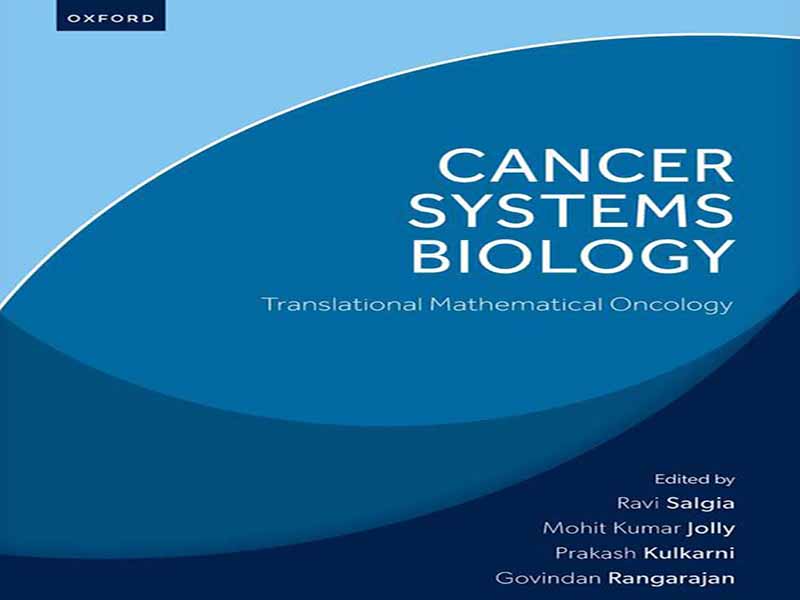- عنوان کتاب: Cancer Systems Biology -Translational Mathematical Oncology
- نویسنده: Ravi Salgia, Mohit Kumar Jolly
- حوزه: تحلیل سرطان
- سال انتشار: 2025
- تعداد صفحه: 473
- زبان اصلی: انگلیسی
- نوع فایل: pdf
- حجم فایل: 9.99 مگابایت
تمدن بشری در طول قرنها شاهد پیشرفتهای قابل توجهی در مراقبتهای بهداشتی بوده است. سرطان یک مسئله چالشبرانگیز است و تعدادی از اکتشافات منجر به مراقبت بهتر از برخی بیماران شده است. با وجود تمام پیشرفتها و نویدهایی که در مورد تشخیص زودهنگام و پزشکی دقیق وجود دارد، ما هنوز با مشکل آزاردهندهای روبرو هستیم – سرطان یک هدف متحرک است. حتی در یک تومور منفرد، تجزیه و تحلیلهای عمیق توالییابی اکنون زیرجمعیتهای چندگانه و فنوتیپی متمایزی را نشان میدهند که به نظر میرسد نمایش آنها از یک مرحله به مرحله دیگر با پیشرفت تومور به طور چشمگیری متفاوت است. کشف جهشهای محرک و ژنهای «قابل اقدام» به زیربنای ژنتیکی افزود و دوران رویکردهای اومیک را که از کل بافت تا سطح تک سلولی شروع میشود، دامن زد. دیدگاه تقلیلگرایانه، همراه با این پیشرفتهای جدید، در ابتدا سرطان را به عنوان یک بیماری پیچیده و ناهمگن ناشی از جهشهای ژنتیکی تثبیت کرد. طبق این دیدگاه، سرطان به خودی خود، پیشرفت آن و کسب مقاومت دارویی، چه ذاتی و چه اکتسابی، بسیار قطعی هستند. با این حال، تحقیقات اخیر این ایده را ترویج داده است که انعطافپذیری فنوتیپی و مکانیسمهای غیرژنتیکی در این رویدادها مهم هستند. به طور فزایندهای، اذعان میشود که سرطان یک سیستم پیچیده تطبیقی و پویا است و علاوه بر جهشهای ژنتیکی، ناهمگونی درون توموری میتواند از طریق مکانیسمهای غیرژنتیکی نیز ایجاد شود. علاوه بر این، آشکار میشود که فنوتیپ بدخیم ناشی از تعاملات پیچیده بین مکانیسمهای ژنتیکی و غیرژنتیکی است. این تعاملات در تغییرات عملکردی در مقیاسهای مکانی-زمانی متعدد، از سطح مولکولی تا سلولی و بافتی، نقش دارند و یک جمعیت ناهمگن از سلولهای سرطانی ایجاد میکنند. پیشرفتهای تکنولوژیکی برای مطالعه سلولهای منفرد و مولکولهای منفرد، در دسترس بودن پلتفرمهای محاسباتی قدرتمند و کاربرد نظریه بازی تکاملی برای تشخیص رفتار گروهی، مدلسازی چندمقیاسی را تقویت کرده و امکان مشاهده کمی فرآیندهای کلیدی در تومورزایی را فراهم کرده است. این تلاشها به عنوان ابزاری قدرتمند برای بررسی جامعتر پدیدههای بیولوژیکی به روشهای تجربی مرتبط عمل کردهاند. بنابراین، درک عمیقتر از این بیماری نه تنها میتواند بینش جدیدی را که برای شخصیسازی درمانها لازم است، فراهم کند، بلکه این دانش میتواند برای مقابله با مقاومت درمانی با تجویز درمان «تطبیقی» (متناوب) به جای درمان استاندارد (پیوسته) که معمولاً، هرچند ناخواسته، ظهور تومورهای مقاوم به دارو را تشویق میکند، نیز مورد استفاده قرار گیرد. با این حال، انجام مطالعات پیشبالینی و آزمایشهای بالینی برای چندین هدف خاص در توالی دوز و برنامههای زمانی متنوع، اغلب بسیار وقتگیر و چالشبرانگیز است. بنابراین، مدلهای ریاضی کالیبره شده و اعتبارسنجی شده، رویکردی جذاب برای ارزیابی پروتکلهای آزمایش نشده در نرمافزار کامپیوتری ارائه میدهند تا مجموعه طرحهای درمانی امیدوارکننده برای ارزیابی را محدود کنند، اهداف درمانی جدید را شناسایی کنند و خطر پیامدهای بالینی نامطلوب ناشی از مکانیسمهای بازخورد پیچیده را کاهش دهند. هدف اصلی این کتاب، علاوه بر ارائه بررسیهای پیشرفته و ایدههای تأملبرانگیز به شیوهای مختصر و مفید، تشویق به تبادل ایدهها از رشتههای مختلف بین پزشکان و دانشمندان علاقهمند به ادغام رویکردهای نظری و تجربی برای مطالعه سرطان است. فصلها ایدهها و مفاهیم جدیدی را ارائه میدهند که نشان میدهند چگونه یک تصویر کمی از سرطان میتواند درک عمیقتری از بیماری ارائه دهد و چگونه یک دیدگاه در سطح سیستم میتواند کلید درک کامل چگونگی پیدایش و پیشرفت سرطان باشد. این کتاب شامل ۴۱ فصل است که در ۹ بخش سازماندهی شدهاند. دو فصل مقدماتی اول، مروری بر رویکرد سیستمها با استفاده از پارادایمهای متعدد ارائه میدهند. بخش بعدی در مورد اومیکس تک سلولی، دیدگاه عمیقی در مورد تجزیه و تحلیل دادههای بزرگ مشتق شده از سلولهای منفرد در سطح سیستمها ارائه میدهد. ویژگیهای اصلی چنین تجزیه و تحلیل چند اومیکس تک سلولی شامل فناوریهایی برای جداسازی تک سلولی، بارکدگذاری و توالییابی برای اندازهگیری انواع مختلف مولکولها از سلولهای منفرد و همچنین تجزیه و تحلیل یکپارچه مولکولها برای توصیف انواع سلولها و عملکرد آنها در رابطه با فرآیندهای پاتوفیزیولوژیک بر اساس امضاهای مولکولی است. علاوه بر این، فرضیههای جدیدی در مورد عملکرد و پیامدهای ناهمگونی بیان از اندازهگیریهای زمانی بیان ژن و اینکه چگونه اصول نظریه اطلاعات میتواند مدلهای تنظیم رونویسی و اتصال شبکه ژن را هدایت کند، ارائه شده است. در ادامه، رویکردهای محاسباتی برای کشف دارو ارائه شده است. رویکردهای محاسباتی بخش مهمی از ابزارهای مورد استفاده در کشف و توسعه دارو را تشکیل میدهند. کاربردهای آنها تقریباً تمام مراحل در خط لوله کشف و توسعه را شامل میشود، از شناسایی هدف گرفته تا کشف سرنخ و از بهینهسازی سرنخ گرفته تا آزمایشهای پیشبالینی و حتی بالینی…
Civilization over centuries has seen considerable advances in healthcare. Cancer is a challenging issue, and a number of discoveries have led to better care of some patients. Despite all the progress and the promise regarding early detection and precision medicine, we are still faced with the nettlesome problem— cancer is a moving target. Even within an individual tumour, deep sequencing analyses now indicate multiple, phenotypically distinct subpopulations whose representation seems to vary dramatically from one stage to the next as the tumour progresses. The discovery of driver mutations and ‘actionable’ genes added to the genetic underpinning and fuelled the era of – omic approaches starting from whole tissue to the single- cell level. The reductionist perspective, together with these new developments, initially established cancer as a complex and heterogeneous disease driven by genetic mutations. According to this view, cancer per se, its progression, and the acquisition of drug resistance, whether innate or acquired, are highly deterministic. However, recent research has promoted the idea that phenotypic plasticity and non- genetic mechanisms are important in these events. Increasingly, it is acknowledged that cancer is a complex adaptive and dynamic system and that, in addition to genetic mutations, intratumoral heterogeneity can also arise through non- genetic mechanisms. Furthermore, it is also becoming evident that the malignant phenotype results from complex interactions between genetic and non- genetic mechanisms. These interactions contribute to functional changes across multiple spatiotemporal scales, from the molecular to cellular and tissue level, creating a heterogeneous cancer cell population. Technological advances to study single cells and single molecules, the availability of powerful computing platforms, and the application of evolutionary game theory to discern group behaviour have galvanized multiscale modelling enabling a quantitative view of the key processes in tumorigenesis. These efforts have served as a powerful means to investigate biological phenomena more comprehensively in experimentally relevant ways. Therefore, a deeper understanding of the disease can not only provide novel insight needed to personalize treatments, but this knowledge may also be used to address therapeutic resistance by administering ‘adaptive’ (intermittent) therapy rather than the standard (continuous) therapy that typically, albeit inadvertently, encourages the emergence of drug- resistant tumours. However, performing pre- clinical studies and clinical trials for multiple specific targets in varied dosing sequence and timing schedules is often too resource- and time- consuming, and hence challenging. Therefore, calibrated and validated mathematical models offer an attractive approach to evaluate untested protocols in silico to narrow the set of promising treatment schemas to be evaluated, to identify new treatment targets, and to reduce the risk of adverse clinical outcomes due to complex feedback mechanisms. The main intent of this book, in addition to providing stateof- the- art reviews and thought- provoking ideas in a concise and succinct manner, is to encourage cross- pollination of ideas from multiple disciplines between clinicians and scientists interested in integrating both theoretical and experimental approaches to study cancer. The chapters provide new ideas and concepts outlining how a quantitative picture of cancer can provide a deeper understanding of the disease and how a systems- level perspective may hold the key to fully comprehend how cancer arises and progresses. The book embodies 41 chapters that are organized in 9 sections. The first two introductory chapters provide an overview of the systems approach using multiple paradigms. The following section on single- cell – omics provides in- depth perspective on the analyses of big data derived from single cells at the systems level. The cardinal features of such single- cell multi- omic analysis include technologies for single- cell isolation, barcoding, and sequencing to measure multiple types of molecules from individual cells as well as the integrative analysis of molecules to characterize cell types and their functions regarding pathophysiological processes based on molecular signatures. Furthermore, new hypotheses about functionality and consequences of expression heterogeneity from timeresolved measurements of gene expression and how the principles from information theory can guide models of transcriptional regulation and gene network connectivity are presented. Next, computational approaches to drug discovery are presented. Computational approaches form an important part of the tools employed in drug discovery and development. Their applications span almost all stages in the discovery and development pipeline, from target identification to lead discovery and from lead optimization to preclinical and even clinical trials. Thus, the chapters devoted to this section cover concepts of structure- and ligand- based drug designing, protein modelling and visualization, molecular docking, virtual screening, molecular dynamics simulation, pharmacophore modelling, and quantitative structure– activity relationship approaches that are typically used in conjunction with conventional biophysical techniques. Some also address the broad area of data analysis, including data mining algorithms, statistical approaches, and practical applications. Topics in this section include problems involving massive and complex datasets, solutions utilizing innovative data mining algorithms and/ or novel statistical approaches, and the objective evaluation of analyses and solutions.
این کتاب را میتوانید از لینک زیر بصورت رایگان دانلود کنید:
Download: Cancer Systems Biology -Translational Mathematical Oncology




































نظرات کاربران